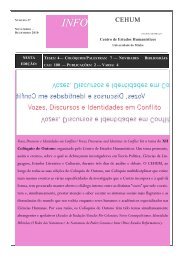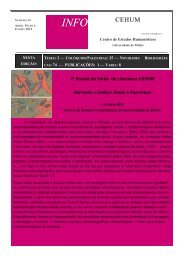Diacritica 25-2_Filosofia.indb - cehum - Universidade do Minho
Diacritica 25-2_Filosofia.indb - cehum - Universidade do Minho
Diacritica 25-2_Filosofia.indb - cehum - Universidade do Minho
You also want an ePaper? Increase the reach of your titles
YUMPU automatically turns print PDFs into web optimized ePapers that Google loves.
QUEEN CAROLINE AND THE PRINT CULTURE OF REGENCY RADICALISM<br />
177<br />
in Sterne’s Tristam Shandy. It is advertised as ‘royal red hot slop, sevenpence<br />
per pail; spooned out every morning at six o’clock, at 153, Fleet-street.<br />
scavengers, sweeps, and others, employed in dirty work, gratefully<br />
partake of this breakfast beverage’ (20). It is a violent attack on extreme<br />
loyalist press and the ‘Constitutional Association’ inscribed in the tradition<br />
of the parodic newspaper. [26] Th e ridicule imposed upon Stoddart can also<br />
symbolise the ridicule of the pretensions to authority of some prominent<br />
fi gures of the cultural establishment.<br />
Hone was the publisher of Th e Printers’ Address to the Queen, And Her<br />
Majesty’s Tribute to the Press, In Answer (BMC 13963), printed by John<br />
Johnson. With 1,345 signatures, it was presented on 11 October by a deputation<br />
of 138 Compositors and Pressmen. Th e illustration (BMC 13947) is a<br />
‘Specimen of the Typographic Art’. Below a careful wood-engraving (21x31<br />
in.) of the Stanhope Press, twelve lines of verse were inset, beginning ‘From<br />
Th ee, O Press! What blessings fl ow!’ Th e Address ends by attributing the<br />
victory of the Queen to the ‘force of Public Opinion, directed and displayed<br />
through the powerful medium of a Free, Uncorrupted, and Incorruptible<br />
British Press’.<br />
In his contribution to the Caroline aff air, Hone did not deviate from<br />
the main radical discourse of opposition. From his satires spring the same<br />
confrontational discourse of Cobbett, Wooler, and Carlile and the same<br />
conviction in the power of the radical press as a liberating force against the<br />
corruption of state.<br />
Th ese are the marks that link Hone with the journalists of the radical<br />
press discussed previously, the more so as Hone edited in 1817 the shortlived<br />
radical periodical Hone’s Reformists’ Register and Weekly Commentary<br />
(1 February 1817-<strong>25</strong> October 1817). Regency radicals were a community in<br />
the political and cultural, as well as in the rhetorical sense of the word. Like<br />
Cobbett, Wooler, and Carlile, Hone knew that cultural appropriation could<br />
be an instrument of individual and collective emancipation.<br />
In the preface to Ancient Mysteries Described, Hone stated that in his<br />
pursuit for knowledge he violated the limits that the aristocracy had defi ned<br />
as ‘the scope of knowledge proper for a man of my condition’ (Hone, 1823:<br />
tor Slop, My Uncle Toby, & My Father (Hone, 1815). Th e title reveals the infl uence of Lawrence<br />
Sterne. According to Grimes (1998b), Hone reprinted this pamphlet in 1820 (Buonapartephobia.<br />
Th e Origin of Dr. Slop’s Name) probably because Stoddart had recently formed a conservative<br />
propaganda organization called the ‘Constitutional Association’.<br />
26 In 1819, three parodic newspapers were published: Th e New Daily Advertiser, Th e Quizzical<br />
Gazette Extraordinary, and Th e Rump Chronicle (Wood, 1994: 202).<br />
<strong>Diacritica</strong> <strong>25</strong>-2_<strong>Filosofia</strong>.<strong>indb</strong> 177 05-01-2012 09:38:28



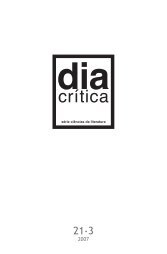

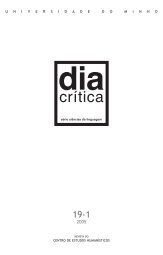



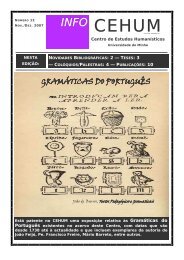

![Programa [pdf] - cehum - Universidade do Minho](https://img.yumpu.com/17305425/1/190x135/programa-pdf-cehum-universidade-do-minho.jpg?quality=85)


